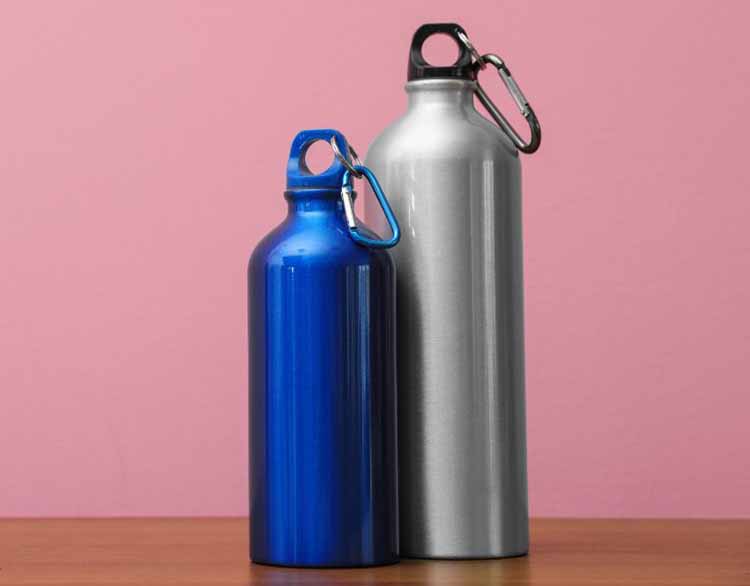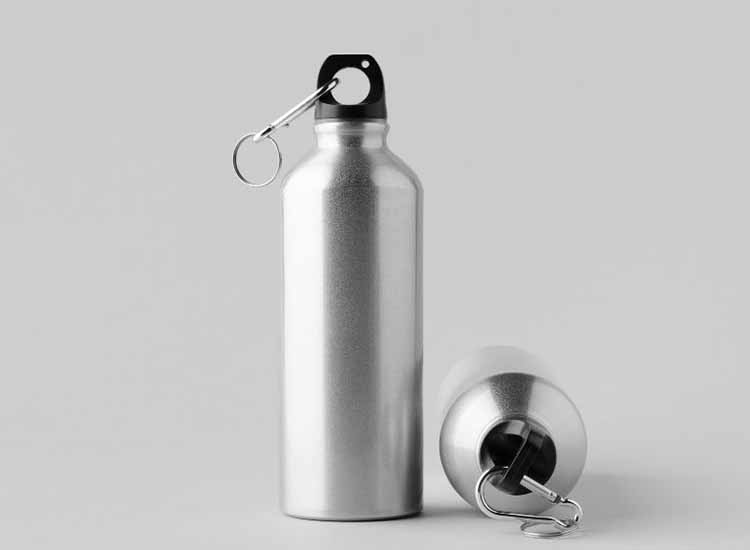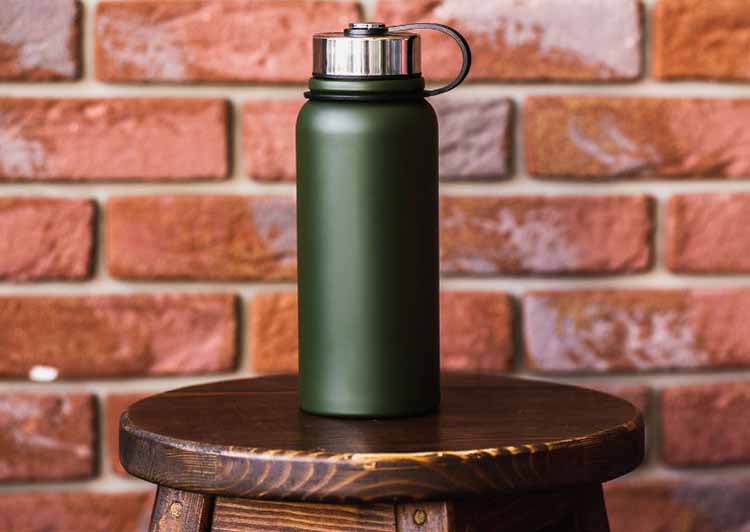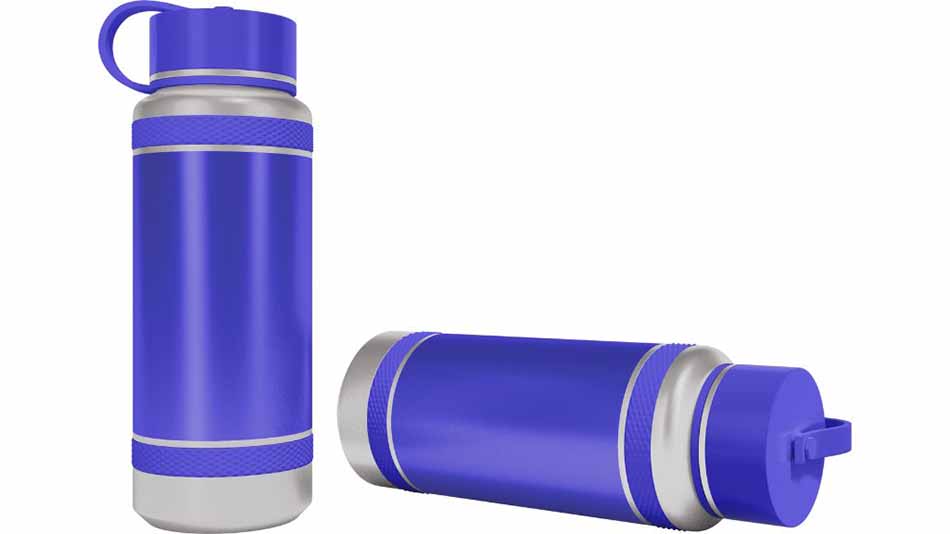Most people decide to have aluminum water because of the metal’s durability, lightweight, impermeability, flexibility, recyclability, and corrosion resistance.
Since aluminum water bottles offer numerous benefits, understanding how they are made will help you know both sides of the coin. So, ‘how are aluminum water bottles made?’
First off, a shearing machine gives aluminum coils a round shape. Then, an extruding machine press gives the aluminum a cylindrical shape. After that, the insides of the bottles are lined and the outsides are coated. Neck forming is done meanwhile. Anodizing, painting, and quality control are the final steps.
This is just an abstract, keep reading to learn the complete manufacturing process of aluminum water bottles.

Manufacturing Process of Aluminum Water Bottles
We will not you make wait anymore, let’s get into the details of how aluminum water bottles are made.
Material Preparation
Aluminum coils -> Shearing machine -> Slugs (round discs)
Recyclable aluminum coils or alloys are inserted in the shearing machine. Those coils are resistant to corrosion and rust. In the shearing machine, the materials are cute and get a round disc-type shape. The discs are called slugs.
Shaping
Slug -> Impact Extrusion (punch) -> Cylindrical body
The shaping is done by a process called impact extrusion press. This process is highly popular in forming unique-shaped metallic containers. Hence, manufacturers use a backward extrusion process that allows the aluminum slug to get a cylindrical shape.
The cylindrical structure of the aluminum is several millimetres thick compared to the slugs. In the extrusion process, manufacturers use a cold slug wall to form the proper shape.
Meanwhile, a punch mechanism helps compress the aluminum alloy to get the precise shape of a container.
Hence, the press machine initiates a sliding motion, ensuring a smooth formation process. The process is repeated over the cylinder as long as the bottle doesn’t get the half-size of the original diameter.
Neck Forming
Cylinder body -> Redrawing & Ironing (dies) -> Neck formation
In this step, manufacturers place a sleeve on the neck of the bottles.
In most cases, manufacturers use a double-turret necker for shaping the bottle’s neck properly. The cylinder-shaped structure goes through a series of dies (the neckers) that stretch and thin the alumium at the top.
The necker is custom-engineered and it shapes the neck into a wide or narrow mouth. It helps the necks to extend a couple of millimetres in length.
Although the process requires a huge amount of pressure, the pressing is carefully balanced to form a threaded closure.
Moreover, manufacturers put an extra metallic element on the top of aluminum water bottle. It ensures that the bottle’s cap twists properly in place. The screw of the cap must be in the right measurement for screwing tightly. It’s important to ensure that any fluid inside the bottle doesn’t leak.

Cleaning and Washing The Bottles
Cleaning -> Drying
This is a straightforward process where manufacturers clean the bottles to remove any residues. They use hot water and a cleaning agent for cleaning purposes. After that, they place the bottles in a drying oven to make them ready for the coating process.
Liner Application
Bottle (optional) -> Coating (lacquer/polymer) -> Curing (ovens)
After washing the bottles, manufacturers use a spray nozzle to line the aluminum water bottles with high-tech polymer plastic. This step is about putting insulating material inside the bottles. Manufacturers use base epoxy phenolic or polyester lacquer as the plastic material.
They let the bottles undergo 365 degrees Fahrenheit heat in an oven. The bottles are placed here for 10 minutes. This process is known as curing.
You can ask, why is there plastic in the aluminum water bottles?
The plastic liner is important to make your drinks taste right. I mean, who wants to drink straight from aluminum? Such drinks taste strongly acidic and you’d never like that. However, if you prefer a metal bottle free from plastic liners, go for stainless steel ones.
So, the liner or coating can improve insulation, prevent taste alteration from the metal, or offer additional corrosion resistance.
Recommended: Best Lightweight Aluminum Water Bottles
Exterior Finishing
Bottle -> Anodizing/Painting -> Enhanced surface
The bottle production process is almost done. Before decorating and painting the bottles, manufacturers apply a base coat to the bottle body. This coat helps the ink layers and other designs to stick to the bottle body.
After that, manufacturers decorate the bottle using an indirect printing technique or silk screen printing according to their preference.
This time, manufacturers add a protective coating to the bottles in the following ways:
- Epoxy spraying: Manufacturers spray the aluminum water bottle using an aluminum coating. But the polymer must solidify for the step. The sleek aluminum coating provides a smooth metallic appearance on the bottle.
- Anodizing: It’s an electrochemical process that creates a thin oxide layer on the aluminum surface. In other words, it’s an acid bath which helps the aluminum oxide layer to become thicker. It eventually enhances the aluminum’s durability and corrosion resistance.
Optimizing Designs and Colors
This time, manufacturers decide whether they will use screen printing, pad printing, or laser printing to enhance the aesthetic appeal of the bottles. Below are the details:
- Screen printing: Screen printing is ideal for large, bold designs with multiple colours. Hence, manufacturers place a mesh screen with a blocked design on the bottle. Ink is squeezed through the open areas of the mesh and leaves the desired design on the bottle’s surface.
- Pad printing: Pad printing is good for small, detailed designs and can handle curved surfaces. In this case, the silicone pad picks up ink from an etched plate and transfers it onto the bottle’s surface.
- Laser engraving: Laser engraving is excellent for precise details, logos, and text. A high-powered laser beam removes material from the bottle’s surface and creates a permanently etched design.
Reheating
Once the desired colours and designs are achieved, the bottles must go to the oven once again. It will ensure that the sprayed colours solidify and provide a smooth exterior. When the bottles are cool and dry, manufacturers inspect the bottles and finish the last steps.

Quality Control & Assembly
Finished bottles -> Inspection
The finished bottles go through a careful inspection process to ensure they are free of defects and meet quality standards. Manufacturers inspect the bottles using both automated and manual checks to identify any imperfections.
Manufacturers let the bottles go through water leakage tests. They check whether the welding of both the outer and inner of the bottles is in good condition. Manufacturers eliminate unqualified bottles.
Most factories go through additional tests such as thermal insulation, unit drop tests, and torque tests. Also, they arrange FDA, EC1935-24, LFGB and other product compliance tests.
When the bottles pass inspection, manufacturers package and prepare the bottles for shipping.
FAQs
What Are The Drawbacks of Aluminum Water Bottles?
There’s a plastic lining inside aluminum water bottles. The liner breaks down over time which can be a concern for people who avoid BPA. Another drawback of aluminum water bottles is that they absorb flavours and odours which require frequent cleaning. Also, they are more prone to scratches compared to stainless steel water bottles.
Does Aluminum Leach Into Your Water From The Bottle?
In most cases, aluminum doesn’t leach into your water. However, the quality of the aluminum product and the pH of the water can lead to a small amount of aluminum leaching. Still, the amount is much lower than becoming any health concern.
Wrapping Up
That’s all about how are aluminum water bottles made.
We tried to share the complex manufacturing process as simply as possible and hope you have got it right. The basic steps of manufacturing aluminum are shaping, neck forming, cleaning, lining, and some touch-ups.
Additional steps vary according to different manufacturers and brands.

